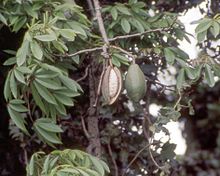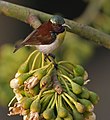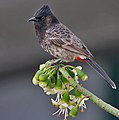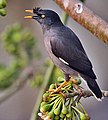Ceiba pentandra: Difference between revisions
m robot Adding: af:Kapokboom |
No edit summary |
||
| Line 58: | Line 58: | ||
== Gallery of ''Ceiba pentandra'' & Birds/a Bat on it == |
== Gallery of ''Ceiba pentandra'' & Birds/a Bat on it == |
||
<gallery> |
<gallery> |
||
Image:Purple-rumped Sunbird (Leptocoma zeylonica) feeding on Kapok (Ceiba pentandra) in Kolkata I IMG 3125.jpg|Purple-rumped Sunbird ''Leptocoma zeylonica'' feeding in [[Kolkata]], [[West Bengal]], [[India]]. |
|||
Image:Purple-rumped Sunbird (Leptocoma zeylonica) feeding on Kapok (Ceiba pentandra) in Kolkata I IMG 3124.jpg|Purple-rumped Sunbird ''Leptocoma zeylonica'' feeding in [[Kolkata]], [[West Bengal]], [[India]]. |
Image:Purple-rumped Sunbird (Leptocoma zeylonica) feeding on Kapok (Ceiba pentandra) in Kolkata I IMG 3124.jpg|Purple-rumped Sunbird ''Leptocoma zeylonica'' feeding in [[Kolkata]], [[West Bengal]], [[India]]. |
||
Image:Purple-rumped Sunbird (Leptocoma zeylonica) feeding on Kapok (Ceiba pentandra) in Kolkata I IMG 1860.jpg|Purple-rumped Sunbird ''Leptocoma zeylonica'' feeding in [[Kolkata]], [[West Bengal]], [[India]]. |
Image:Purple-rumped Sunbird (Leptocoma zeylonica) feeding on Kapok (Ceiba pentandra) in Kolkata I IMG 1860.jpg|Purple-rumped Sunbird ''Leptocoma zeylonica'' feeding in [[Kolkata]], [[West Bengal]], [[India]]. |
||
| Line 103: | Line 103: | ||
[[nah:Pochotl]] |
[[nah:Pochotl]] |
||
[[nl:Kapokboom]] |
[[nl:Kapokboom]] |
||
[[pt:Mafumeira]] |
|||
[[ja:カポック]] |
[[ja:カポック]] |
||
[[pl:Puchowiec pięciopręcikowy]] |
[[pl:Puchowiec pięciopręcikowy]] |
||
Revision as of 22:45, 5 September 2008
- For the children's book, see The Great Kapok Tree.
| Kapok | |
|---|---|

| |
| Kapok planted in Honolulu, Hawaii | |
| Scientific classification | |
| Kingdom: | |
| Division: | |
| Class: | |
| Order: | |
| Family: | |
| Genus: | |
| Species: | C. pentandra
|
| Binomial name | |
| Ceiba pentandra | |


Kapok (Ceiba pentandra) is a tropical tree of the order Malvales and the family Malvaceae (previously separated in the family Bombacaceae), native to Mexico, Central America and the Caribbean, northern South America, and (as the variety C. pentandra var. guineensis) to tropical west Africa. The word is also used for the fibre obtained from its seed pods. The tree is also known as the Java cotton, Java kapok, or ceiba. It is a sacred symbol in Maya mythology.
The tree grows to 60-70 m (200-230 ft) tall and has a very substantial trunk up to 3 m (10 ft) in diameter with buttresses. The trunk and many of the larger branches are densely crowded with very large, robust simple thorns. The leaves are compound of 5 to 9 leaflets, each up to 20 cm (8 in) and palm like. Adult trees produce several hundred 15 cm (6 in) seed pods. The pods contain seeds surrounded by a fluffy, yellowish fiber that is a mix of lignin and cellulose.
Uses

The fibre is light, very buoyant, resilient, highly flammable and resistant to water. The process of harvesting and separating the fibre is labour-intensive and manual. It cannot be spun but is used as an alternative to down as filling in mattresses, pillows, upholstery, teddy bears, zafus and for insulation. It was previously much used in life jackets and similar devices. The fibre has been largely replaced by man-made materials. The seeds produce an oil used locally in soap and that can be used as fertilizer.
In Southeast Asian countries kapok has larger seed pods and the fibre which is highly flammable is used as a fuel in fire pistons, in Thailand called taban fai ตะบันไฟ.
The commercial tree is most heavily cultivated in Asia, notably in Java (hence its nicknames), Philippines, and Malaysia, but also in South America.
A similar fibre is found in the Indian Bombax ceiba (also known as Bombax malabaricum or "silk-cotton tree"). It is termed Indian kapok and is darker in colour and less buoyant than the true variety. Another species, the Kapok Bush Aerva javanica, produces a material that is used for stuffing pillows.[1]
This tree is the official national tree of Puerto Rico.
Ethnomedical uses
Ceiba pentandra bark decoction has been used as a diuretic, aphrodisiac, and to treat headache, as well as type II diabetes.
Ceiba pentandra is used as an additive to some versions of the hallucinogenic drink Ayahuasca.[2]
References
- ^ Burndud (1990). Wanggalili; Yinjibarndi and Ngarluma Plants. Juluwarlu Aboriginal Corporation. p. 19.
- ^ Ayahuasca Analogues
- Germplasm Resources Information Network: Ceiba pentandra
- The larger seed pods of SEA kapok and its use as a fuel in fire pistons
- Ceiba pentandra in Brunken, U., Schmidt, M., Dressler, S., Janssen, T., Thombiano, A. & Zizka, G. 2008. West African plants - A Photo Guide. Forschungsinstitut Senckenberg, Frankfurt/Main.
Gallery
-
Buttress roots
-
Cortex
-
Fruit

























